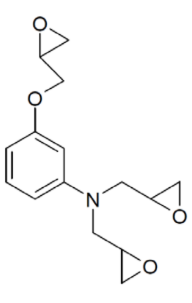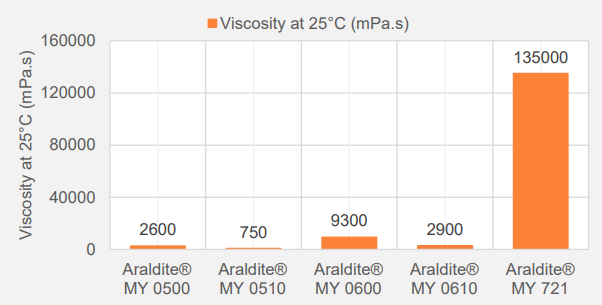Enhanced TDS
Identification & Functionality
- Blend
- No
- CAS Number
- 71604-74-5
- CASE Ingredients Functions
- Chemical Family
- Composite Materials Functions
- Function
- Hardener,Viscosity Modifier,Binder & Resin,Crosslinking Agent
- Single Ingredient
- Yes
- Technologies
- Product Families
- Chemical Structure

Features & Benefits
- CASE Ingredients Features
- Materials Features
Applications & Uses
- Adhesive & Sealant End Applications
- Composites End Use
- Markets
- Applications
Properties
- Physical Form
- Notes
Typical Physical Properties: Unless otherwise stated, the data were determined with typical production batches using standard test methods. They are typical values only, and do not constitute a product specification.
The following properties were determined from samples cured for 2 hours at 120°C + 1 hour at 160°C + 2 hours at 180°C, unless a different cure is specified.Glass transition temperature: A Tg of 220-235°C was also found after 48 h water immersion at 71°C.
Mix Ratio: We recommend that the components are weighed with an accurate balance to prevent mixing inaccuracies which can affect the properties of the system. The components should be mixed thoroughly to ensure homogeneity.
Technical Details & Test Data
- Viscosity Graph

Packaging & Availability
- Regional Availability
Storage & Handling
- Storage Information
ARALDITE® MY 0600 Resin should never be stored near warm areas, particularly near heat sources or hot equipment, or even in direct sunlight, because violent exothermic reaction or explosion may result. Store in a sealed container at or below 5°C (40 °F). Maximum temperature this product should be subjected to while thawing for use should not exceed 40°C (100°F). Under these storage conditions the shelf life is 9 months (from date of manufacture).
To facilitate handling of ARALDITE® MY 0600 as a workable liquid, warm the container gradually by letting it stand in an area at room temperature (approximately 24°C (75°F) prior to use. Never accelerate warming by using hot ovens, band heaters, hot plates, open flames, or any means, which could cause a “hot spot.” Such practices may initiate violent exothermic reaction or explosion. Contamination, especially by acidic or basic substances, may also start a violent exothermic reaction and must be avoided.
Other
- Appearance
- Clear liquid
- Color (SDS)
- Yellow
- Odor (SDS)
- Slight
- Mechanical Properties
Value Units Test Method / Conditions Flexural Strength 18000.0-20000.0 psi psi ISO 178 - Physical Properties
Value Units Test Method / Conditions Density 1.21-1.22 g/cm³ g/cm³ ISO 1675 at 25°C Flash Point min. 100.0 °C °C Pensky-Martens Closed Cup (PMCC) Flash Point min. 100.0 °C °C ISO 2719 Glass Transition Temperature (Tg) 215.0-220.0 °C °C Dynamic Mechanical Analysis (DMA) Sample cure: 3 h / 120°C + 1 h / 160°C + 2 h / 180°C Glass Transition Temperature (Tg) 215.0-220.0 °C °C Thermomechanical Analyzer Sample cure: 3 h / 120°C + 1 h / 160°C + 2 h / 180°C Viscosity 7000.0-13000.0 cPs cPs at 25°C
